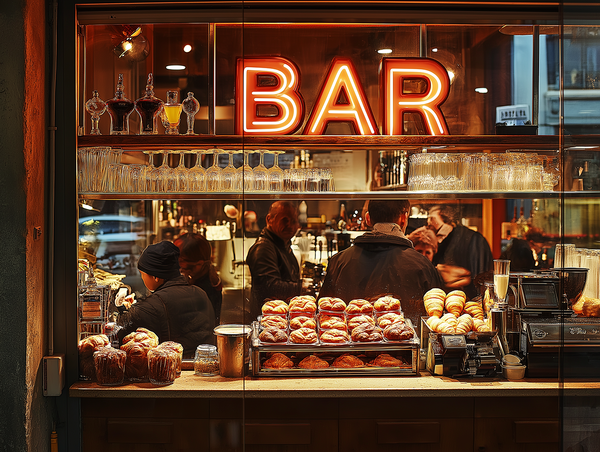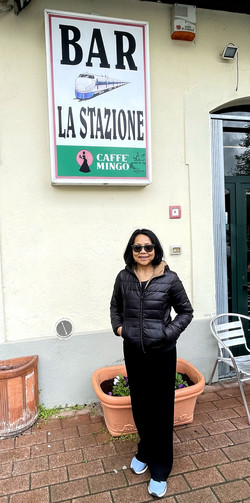An Italian Bar: A Dynamic Venue for Enhancing Connection and Enjoyment

[아츠앤컬쳐] 이탈리아에서 아침에 바(Bar)를 찾는 일은 단순한 식사가 아니라, 하루를 여는 중요한 사교 의식이다. 이른 아침, 사람들은 동네 바에 들러 에스프레소와 코르네토(크로아상)로 하루를 시작한다. “일 솔리토?(늘 드시던 거요?)”는 바리스타가 단골손님에게 “부온조르노!(좋은 아침이에요!)”라는 인사 후에 으레 건네는 질문이다.
바리스타는 마치 가족처럼 손님의 커피 취향을 기억한다. 룽고 마키아토인지 띠에피도 카푸치노인지, 또 투명 머그인지 도자기 잔인지 세심하게 챙긴다. 손님들은 바 카운터에서 바리스타나 다른 사람들과 짧은 대화를 하며, 간단한 아침 식사와 위로를 나누고 “부오나 조르나타!(좋은 하루 보내세요!)”라는 인사를 남기며 바를 나선다.
이탈리아의 일상과 문화의 일부인 바는 단순한 커피숍이 아니다. 커뮤니티의 중심이자 만남의 장소이며, 관계를 맺고 이어가는 공간이다. 사람들은 하루에도 몇 번씩 들러 일, 취미, 정치, 가족 이야기를 나누고, 소식과 가십, 웃음을 터뜨린다.
이런 바의 소란스러움은 따뜻한 카푸치노와 달콤한 페이스트리, 샌드위치, 미니 피자와 함께 알코올/논알코올 음료의 기쁨과 어우러진다. 아이부터 노인까지 온 연령대가 함께 아침 식사, 가벼운 점심, 오후의 아페리티보(해피아워)를 즐기며 모이는 장소, 그곳이 바로 이탈리아의 바다. 신문과 잡지를 읽고, 대형 TV로 스포츠를 보며, 친구들과 카드놀이를 하는 곳도 바로 이곳이다.

‘BAR’라는 단어는 1898년 피렌체에서 알레산드로 마나레시라는 사업가가 바를 처음으로 열며 사용한 것으로, “Banco A Ristoro(간이 음료대)”의 머리글자를 따서 이름을 붙였다고 한다.
많은 바에서는 대대로 전해진 레시피로 직접 페이스트리를 만든다. 또는 매일 아침 지역 제과점에서 전통적인 빵을 받아오기도 한다. 각 지역에는 고유 디저트가 있는데, 베네토주 트레비소의 ‘티라미수’는 “나를 끌어올려줘”라는 뜻처럼 기분 좋은 단맛을 전한다. 로마의 ‘마리토쪼’(폭신한 빵 속에 휘핑크림을 채운다), 나폴리의 ‘스폴리아텔라’(조개껍질 모양에 리코타치즈와 절인 과일이 들어있다), 시칠리아의 ‘칸놀리’(튀긴 도우에 리코타크림과 절인 과일, 초콜릿 칩을 채운다)와 ‘카사타’(리코타와 아몬드 페이스트, 오렌지, 초콜릿, 와인이 어우러진 것), 토스카나의 ‘칸투치’(아몬드 비스킷으로 보통 디저트 와인에 적셔 먹는다)와 시에나의 ‘판포르테’(과일과 견과, 향신료가 들어간 케이크) 등은 지역의 자부심이 담긴 맛이다. 이런 디저트는 단순한 후식을 넘어 지역의 자부심과 문화유산을 상징하며, 세계적으로도 사랑받고 있다.
특별한 명절, 축하 행사, 공휴일 또는 일요일 점심 식사 후에는 바 파스티체리아에서 케이크 ‘파스티치니’를 주문한다. 베리, 레몬 커스터드, 초콜릿, 샹티 크림, 피스타치오, 크림치즈 등으로 만든 달콤한 케이크를 나누며, 맛과 재료, 경험, 만드는 법에 대한 이야기까지 함께 즐긴다. 가족, 친구, 이웃과 대화하는 이 순간이야말로 바 문화의 정수라 할 수 있다.

An Italian Bar: A Dynamic Venue for Enhancing Connection and Enjoyment
Rituals of going to a bar for breakfast and having social interaction in Italy starts in early morning, when Italians usually come to the local bars for an espresso and a cornetto (croisant). “Il solito?” (“the usual?”) is the question comes from a barista to a regular customer after warm greetings “buongiorno” (“good morning”). A barista is like part of the family who remembers what kind of coffee that you usually take, can be un macchiato lungo a (long macchiato), or cappuccino tiepido (warm cappuccino) and in which cup, whether in a transparent mug or ceramic one. People would exchange little chat with the barista and with other people at the bar counter for a quick breakfast and comfort before starting the day and express good wishes “buona giornata!” before they leave the bar.

As part of Italians daily life and culture, a bar is much more than a place to grab a cup of coffee and a croisant, it’s a community center, a social hub, a meeting point, where people visit throughout the day even more than once, to create and foster connection, to catch up, have conversation about their works, hobbies, politics, families, to exchange news, gossips, and laughs.
These “noises” that the people make in the bar are blended with the pleasure of enjoying some nice cappuccino and sweet pastries, or some alcohol/non alcohol drink with savory sandwiches or small pizzas with family, friends, and colleagues. It’s a gathering place of people in all ages, from children to grandparents for having breakfast, light lunch, and afternoon aperitivo (happy hour time). The Italian bar is also a place where people read daily newspapers, magazines, watch sports on big TV screens and play cards together with friends.
The word “BAR” appears to be used for the first time by an Italian entrepreneur, Alessandro Manaresi, who opened the first bar in Florence, Italy in 1898 using the three letters as the acronym for “Banco A Ristoro”(=a refreshment counter).

Many bars are equipped with their own pastries production, with recipes pass down through generations, and some bars have their regular pastries producers that provide sweet and savory pastries daily. Pastry traditions are diverse, each region or town in Italy has its own specialties, for example Tiramisu, born in Treviso, Veneto. The word Tiramisu literally means “lift me up”, the ingredients include layers of mascarpone cream, coffee-soaked ladyfingers biscuits, egg yolks and cocoa powder. In Rome, there is a traditional cake called Maritozzo, a sweet bun middle part sliced open and stuffed with rich whipped cream. Sfogliatella, a famous pastry from Naples, a shell-shaped thin crispy layers pastry, stuffed with ricotta and candied fruit. In Sicily, there is Cannoli, fried tubes dough filled with sweetened ricotta cheese, candied fruit and chocolate chips. And also Cassata, a traditional cake made of fresh ricotta, almond paste, candied orange and cedar, chocolate and marsala. Tuscany is famous for Cantucci, almond biscuits typically dipped in Vin Santo wine before consume, and Panforte, a dense fruit, nuts and herbs cake from Siena.
These sweets are more than just desserts, they are symbols of local pride and heritage, which some of them are famous around the world.
On special occasions, celebrations, holidays, or Sunday lunches, people go to bar pasticceria and order a big or small tray consist of assorted sweet cakes, namely pasticcini with mixed berries, lemon custard, chocolate, chantilly cream, pistachio, sweet cheese and those delicious sweet cakes mentioned above to be enjoyed together and pleasurably talked about the taste, ingredients, experiences, and how to prepare them with their loved ones.

글 ㅣ Maureen Siwy
Culinary and social traditions researcher

